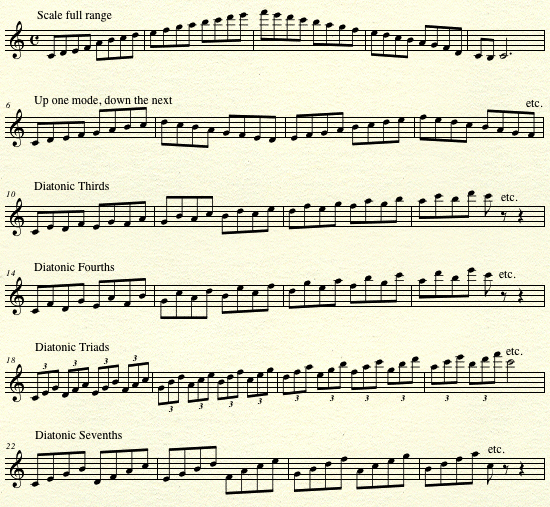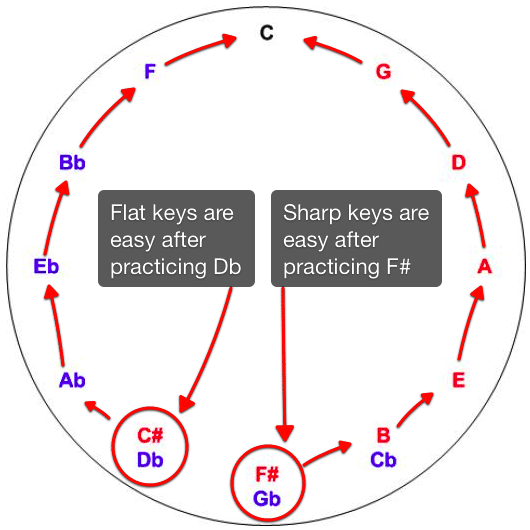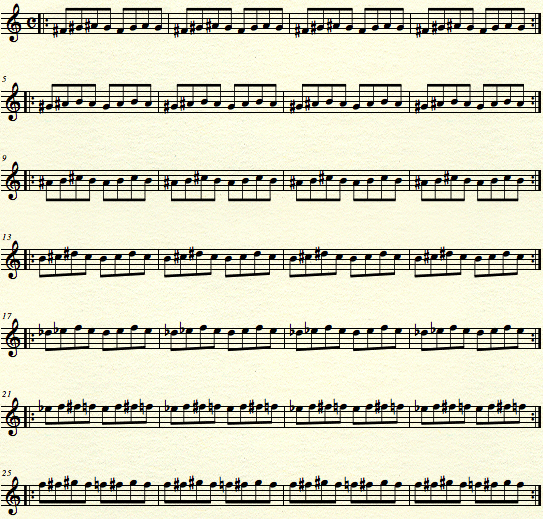How to practice scales for speed is something every musician wants to know. What scale exercises can you practice to quickly attain a high level of speed and accuracy? Are there certain keys you should start with, or specific approaches you should try?
Today we’re going to teach you some valuable tactics to practice all your scales in all 12 keys. Soon, you’ll be able to take your Major Scales, Minor Scales (natural, harmonic, and melodic), Whole Tone Scales, and Diminished Scales to a new level of proficiency.
But before we get into the specific exercises, let’s talk about the standard way that nearly everyone is taught to practice scales…
Typical scale practice
Most college jazz programs, as well as most books, have a typical way they present scale practice.
And it’s by no means bad, in fact, you can improve your scales a lot with this basic routine, which goes something like this…
For all Major, Minor ( all three: natural, harmonic, & melodic), Whole-Tone, and Diminished scales, you practice all 6 of these exercises in all keys, going up and down the full range of your instrument:
- Starting from root, play to as high as you can go, then back down to as low as you can go, and then back up the root
- One mode up, the next down and so on (up and down)
- The scale in diatonic 3rds (up and down)
- Then diatonic 4ths (up and down)
- Then diatonic triads (up and down)
- And finally diatonic seventh chords (up and down)
Here are simple examples using the C Major Scale:
Seems simple enough, right?
It sounds easy in theory, but in actuality it’s quite a bit of work. Six scale types, six exercises in all keys…
I can tell you from experience, while beneficial, trying to tackle your scales this way is pretty overwhelming and not necessarily aimed toward practicing scales for speed.
Of course, you eventually want to be able to play these exercises with ease, however, there are certainly exercises that are more geared toward developing speed with your scales.
But first, let’s talk about which keys to start with…
The Two keys to mastery
We are usually taught to practice our scales in all keys right away.
So instead of focusing on learning one scale really well, we try to hit all the keys as quickly as possible, leaving us with not much better technique than when we started.
But here’s the thing…
If you focus your studies on two specific keys, F# and Db, the others will come naturally.
Most people start with the key of C Major…but the from there, it’s an up hill battle. Every single key you work on after C will be more difficult for you.
So rather than starting at C, start from F#…it’s all downhill to the other sharp keys. And from Db it’s smooth sailing through the other flat keys.
Keys to Focus on
Scale Speed Drills
I want you to try a quick experiment…
Try playing diatonic 3rds (as in the 3rd line of the typical scale practice above) in the key of F#. Notice that they are difficult to play fast and smooth?
The natural shape of diatonic 3rds does not easily allow for speed or repetition…
Now, try playing an F# triad up and down as in the first line of the Triadic Speed Drill a little further down this lesson. Then try it quickly. Notice how easy it is to play fast?
Find shapes like these triadic shapes that allow for speed and repetition in your practice
This is what I like to call the Triadic Speed Drill (shown below). You play each triad in a scale, repeating it over and over until it’s extremely fast and smooth with a metronome.
For any part the scale that is difficult, you isolate it, slow it down and work out the fingerings until it’s effortless.
Triadic Speed Drill in F#
Next, play what we’ll call the Whole Triadic Sequence up and down your instrument (shown below). After drilling your diatonic triads for increased speed through the Triadic Speed Drill, this will be a piece of cake.
Whole Triadic Sequence in F#
The same approach can be used for scalar segments. We’ll call this the Scalar Speed Drill (shown below)
Scalar Speed Drill in F#
After practicing the Scalar Speed Drill with 3 notes (each line uses three notes of the scale) try using 5 notes. So the first group of five notes would be F# through C#, the second would be G# through D# and so on.
Try playing the whole scale now too. After working on these small scalar units, the entire scale will flow much better than it ever has.
Articulation and scales
Always start by slurring everything. This forces you to focus on keeping your sound supported and even throughout the registers. Dial in every note.
Once you’ve practiced slurring everything, try using light, off beat tonguing, commonly referred to as “jazz articulation.” Read through this article on articulation, for a better idea of how to go about doing this.
Isolate the high and low ranges
Both the Triadic Speed Drill and the Scalar Speed Drill isolate sections of your instrument, allowing you to perfect otherwise neglected parts of a scale. The most difficult ranges of an instrument tend to be the extreme low and the extreme high. Hence, these areas require the most work. Spend double the time you spend on the middle of your instrument, on the extreme ranges.
Use a metronome
I can’t emphasize the use of a metronome enough. I begin with the metronome around quarter note = 72 bpm (slower for high and low ranges). I like to play these exercises in note groupings of 4, so I play 4 notes to every click of the metronome.
I then gradually increase the metronome until I’m playing an exercise solid at 104 bpm. I stay there for a while and then increase the tempo, aiming for over 130 bpm. Sometimes I’ll hit a wall, bring it back down, and then increase the tempo again. Keep increasing the tempo, but stay in complete control, decreasing when needed.
Scale practice wrap up
To sum up how you can practice scales for speed…
- Start by focusing on only two keys: F# and Db.
- Do the triadic and scalar speed drills with a metronome until you have them mastered in those keys. Isolate the high and low ranges.
- Then practice the whole triadic sequence and the whole scale. Start slow! Set the metronome slow enough to execute everything perfectly. This may be very slow, but that is ok. Better to be slow and perfect than fast and out of control.
Once you start with F# Major, I guarantee that B Major turns out to be really easy. After B, E will be a breeze, and so on until you get to C…
Similarly, after mastery of Db Major, Ab Major will be easy and then you’ll work quickly through the rest of the flats until you arrive at F.
Before moving onto any other scale qualities make sure you have a solid grasp on all 12 Major Scales – these are your foundation for everything else.
Mastering these will let you easily move through all the other scales we talked about earlier. Practice your scales like this for the next three months and I promise you…your technique will rise to new heights!















